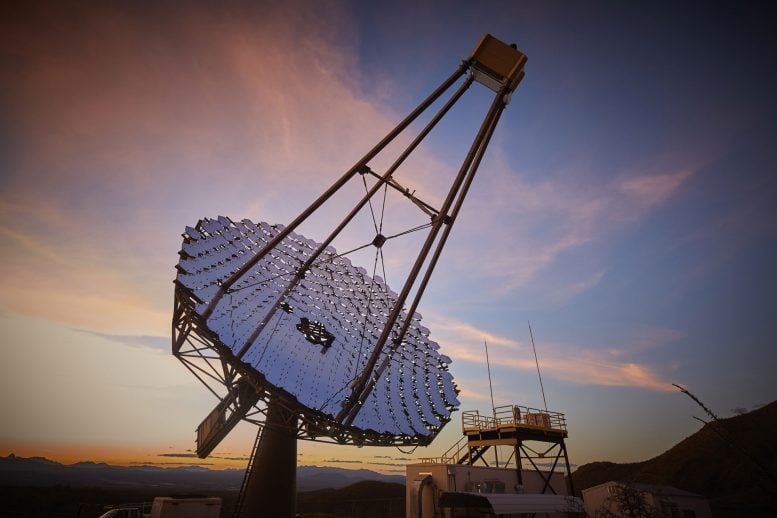
The VERITAS array searches for very high-energy gamma rays and cosmic rays from its location in the Santa Rita Mountains south of Tucson, Arizona. Credit: CfA
Scientists in the VERITAS (Very Energetic Radiation Imaging Telescope Array System) Collaboration have published a paper in Nature Astronomy journal detailing the results of their work with the VERITAS array—located at the Center for Astrophysics’ Fred Lawrence Whipple Observatory in Amado, Arizona—to measure the smallest apparent size of stars in the night sky known to date.
Measurements taken using the VERITAS telescopes revealed the diameter of a giant star located 2,674 light years from Earth. Taken on February 22, 2018, at the Whipple Observatory, data revealed the star to be 11 times the diameter of Earth’s Sun. Using the four 12-m gamma-ray telescopes of VERITAS, the team collected 300 images per second to detect the diffraction pattern in the shadow sweeping past the telescopes as the star TYC 5517-227-1 was occulted by the 60-km (37-mile) asteroid Imprinetta. “From these data, the brightness profile of the diffraction pattern of the star was reconstructed with high accuracy,” said Dr. Michael Daniel, Operations Manager, VERITAS. “This allowed us to determine the actual diameter of the star, and determine it to be a red giant, although it could previously be classified as ambiguous.”
Three months later, on May 22, 2018, the team repeated the experiment when asteroid Penelope—diameter 88-km (55-mile) —occulted star TYC 278-748-1 located 700 light years from Earth. “Using the same formula for data collection and calculations, we determined this star to be 2.17 times the diameter Earth’s Sun,” said Daniel. “This direct measurement allowed us to correct an earlier estimation that placed the star’s diameter at 1.415 times that of our sun.”
With almost any star on the night sky too distant from Earth to be directly measured using even the best of optical telescopes, scientists overcame these limitations using diffraction, which occurs when an object, like an asteroid, passes in front of a star, making a shadow called an occultation. “The incredibly faint shadows of asteroids pass over us every day,” explained Dr. Tarek Hassan, DESY. “But the rim of the shadow isn’t perfectly sharp. Instead, wrinkles of light surround the central shadow, like water ripples.”
For VERITAS scientists, however, the task was not as easy as turning telescopes to the sky. “Asteroid occultations are difficult to predict,” said Daniel. “The only chance to catch the diffraction pattern is to make very fast snapshots when the shadow of the occultation sweeps across the telescope.”
Astronomers have similarly used this method— which measures to an angular diameter of roughly one milliarcsecond—to measure angular sizes of stars occulted by Earth’s moon. “The trouble is that not many telescopes are large enough for the occultation method to measure the diffraction pattern with confirmed accuracy over the turbulence in the Earth’s atmosphere,” said Daniel. “VERITAS telescopes are uniquely sensitive as we use them primarily for observing faint light from very-high-energy gamma rays and cosmic rays. While they do not produce images as elegant as those from traditional optical telescopes, they see and capture fast variations of light, and we estimate that they can analyze stars up to ten times farther away with extreme accuracy than optical telescopes using the lunar occultation method can.”
At its conclusion, the pilot study resulted in the direct measurement of the size of a star at the smallest angular scale in the night sky to date, and established a new method to determine the angular diameter of stars.
About VERITAS
VERITAS (Very Energetic Radiation Imaging Telescope Array System) is a ground-based array of four, 12-m optical reflectors for gamma-ray astronomy located at the Center for Astrophysics | Harvard & Smithsonian, Fred Lawrence Whipple Observatory in Amado, Arizona. VERITAS is the world’s most sensitive very-high-energy gamma-ray observatory, and it detects gamma rays via the extremely brief flashes of blue “Cherenkov” light they create when they are absorbed in the Earth’s atmosphere.
VERITAS is supported by grants from the U.S. Department of Energy Office of Science, the U.S. National Science Foundation, and the Smithsonian Institution, and by NSERC in Canada.
The VERITAS Collaboration consists of about 80 scientists from 20 institutions in the United States, Canada, Germany and Ireland.
For more information about VERITAS visit http://veritas.sao.arizona.edu
About DESY
DESY is one of the world’s leading particle accelerator centers. Researchers use the large‐scale facilities at DESY to explore the microcosm in all its variety – ranging from the interaction of tiny elementary particles to the behavior of innovative nanomaterials and the vital processes that take place between biomolecules to the great mysteries of the universe. The accelerators and detectors that DESY develops and builds at its locations in Hamburg and Zeuthen are unique research tools. DESY is a member of the Helmholtz Association and receives its funding from the German Federal Ministry of Education and Research (BMBF) (90 percent) and the German federal states of Hamburg and Brandenburg (10 percent).
Reference: “Direct measurement of stellar angular diameters by the VERITAS Cherenkov telescopes” by Giuri, O. Gueta, D. Hanna, J. P. Halpern, T. Hassan, J. Holder, G. Hughes, T. B. Humensky, A. M. Joyce, P. Kaaret, P. Kar, N. Kelley-Hoskins, M. Kertzman, D. Kieda, M. Krause, M. J. Lang, T. T. Y. Lin, G. Maier, N. Matthews, P. Moriarty, R. Mukherjee, D. Nieto, M. Nievas-Rosillo, S. O’Brien, R. A. Ong, N. Park, A. Petrashyk, M. Pohl, E. Pueschel, J. Quinn, K. Ragan, P. T. Reynolds, G. T. Richards, E. Roache, C. Rulten, I. Sadeh, M. Santander, G. H. Sembroski, K. Shahinyan, I. Sushch, S. P. Wakely, R. M. Wells, P. Wilcox, A. Wilhelm, D. A. Williams and T. J. Williamson, 15 April 2019, Nature Astronomy.
DOI: 10.1038/s41550-019-0741-z

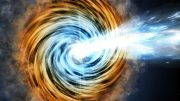
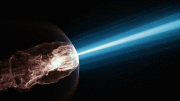
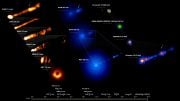
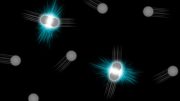
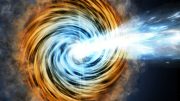

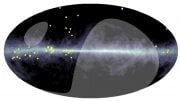
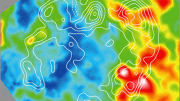
It’s great for the knowledge you share with us, I will always follow your blog and will share your blog with my friends.